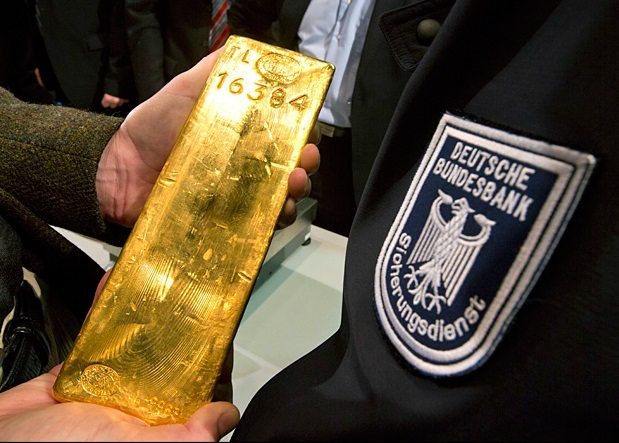
Yesterday, Germany’s Central Bank the Bundesbank published a 2,300 page list of its gold holdings. The bars are held in Germany, England, France, and the Federal Reserve Bank of New York. A total of 109 million ounces are held between the sites, with the Fed holding the lion’s share of 46.5 million ounces.
What remains unclear is how the bars were counted or tested, given that the purity of each bar is listed to the ten thousandth of a percent, and how Germany knows that the the gold set aside as its own is actually its own and not used as the reserve for a different country. In other words, how can Germany be sure that the Federal Reserve is not engaged in fractional reserve gold banking?
One argument is that it doesn’t matter, because as long as the Fed says that Germany owns X gold, that gold can be “used” to pay off debts and transferred in title to someone else or some other country. In the words of CNBC’s John Carney:
In reality, it does not matter one bit whether the Federal Reserve Bank of New York actually has the German central bank’s gold or whether the gold is pure. As long as the Fed says it is there, it is as good as there for all practical purposes to which it might be put. It can be sold, leased out, used as collateral, employed to extinguish liabilities and counted as bank capital just the same whether it exists or not.
This argument is preposterous. Just as fractional reserve banking can lead to bank runs and financial crises, so can a gold run on a central bank. As long as nobody wants the gold physically back, then a fractional reserve gold system, supposing it exists, can continue, with the only effect being the ability to inflate the money supply more. The supply of gold is thought to be more than it is, and therefore the price of gold goes down and the relative value of a fiat dollar or Euro goes up in gold terms, giving cover to central banks to print more money. This is what reinforces faith in central banks and the entire fiat monetary system.
But if the gold is not actually there, then faith in central banks vanishes. This would be no big deal if not for the fact that central banks produce all the fiat currency in the world, the value of which is backed by faith in central banks.
The effect then would be a massive revaluation of gold and global fiat currencies, as the world begins to realize that the supply of gold held by central banks is really much smaller than all the central banks claim it is.
Carney realizes this without explicitly spelling out the consequences:
There is nothing to be gained by inspecting the gold. If it is all there and pure, there is no difference from an undiscovered absence. But if the gold isn’t there, well, calamity could follow as trust in the central bank gold depositories evaporated instantly.
So on the one hand Carney says it doesn’t matter. On the other hand, he says that calamity is at the doorstep if the gold is not there. What Carney is saying is that if it isn’t there, the monetary system as we know it could break down, leaving gold holders suddenly with a lot of purchasing power that used to be in the hands of fiat currency holders (read banks and central banks).




